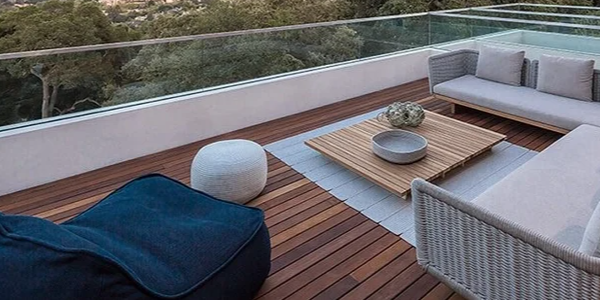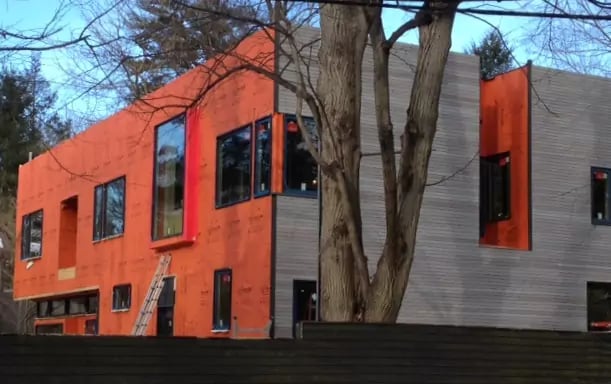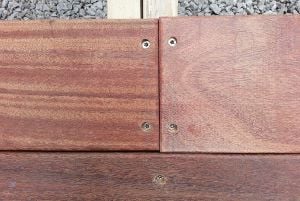
Related Posts



I love wood; it is a beautiful, all natural renewable resource. Wood is good, but it is still wood…and all wood moves, especially during the initial acclimation process. Failure to ignore this simple but important fact of nature will not make it go away. Because we care deeply about the short term and long term satisfaction of our clients, we offer high quality hardwood decking and siding materials that should last, beautifully, for many years. The better you treat your new wood siding or decking, particularly while it initially acclimates, the more likely you are to be thrilled with your project.

FSC Machiche hardwood deck with panoramic view
Keep in mind that although hardwood decking and siding species such as Ipe, Cumaru, Garapa, FSC Machiche, Jatoba (Brazilian Cherry) and others will last a long time and perform well. But they are still susceptible to the laws of nature. Before you get started with your deck project, treat the wood properly before you install it. To help you enjoy your hardwood decking and siding immediately, we have put together this list of Do’s and Don’ts for hardwood decking and siding to help you enjoy your project right away.
 Ipe wood rainscreen siding
Ipe wood rainscreen siding
DO LISTAlways Do This for Proper Acclimation of Hardwood Decking or Siding |
DON’T LISTNever Do This for Proper Acclimation of Hardwood Decking or Siding |
|
|
DO: Always allow your decking or siding wood to properly acclimate on site prior to installation. One to two weeks is usually sufficient, as long as your wood is stored properly during this period. |
DON'T: Never install your wood decking or siding immediately. If your outdoor wood acclimates too quickly, you may get excessive surface checking, cupping, twisting, warping or other problems. |
|
|
DO: Always store your wood decking or siding up off the ground. If you must let your wood acclimate over dirt or lawn areas, always keep your wood stacked a minimum of 8” to 12” off the ground. A tarp on the ground (not your pile) will also help reduce moisture from rising out of the earth. |
DON'T: Never store your wood directly on the ground, driveway or concrete. If water settles on hard surfaces, your wood will literally be sitting in a puddle of water. If you store wood too close to the ground, it will “wick” moisture out of the earth and wreak havoc on your wood decking or siding |
|
|
DO: Always use “spacers” or “stickers” between rows of decking or siding. This allows air flow between layers of wood, which will help the acclimation process along. |
DON'T: Never stack rows of decking or siding directly on top of one another. Stacking wood without spacers will not allow it to breathe and acclimate properly. |
|
|
DO: Always cover the top of your stack of wood decking and siding only. Leave the sides and ends of your pile open to let the air circulate properly. This is like using an umbrella at the beach, it keeps off the sun, but lets the breezes through to dry the wood. If there is an area on the property that gets a breeze, this is the ideal area for gentle acclimation. |
DON'T: Never cover the entire pile of wood decking or siding while it acclimates. You must leave the sides and ends of the stacks open. Covering the entire pile traps moisture and is often worse than no cover at all. It’s like locking the wood inside a steam bath. This is sure to cause cupping, swelling and lots of problems. |
|
|
DO: Always use a sheet of OSB or plywood or wood scraps from your job site or a canvas type of tarp on the top only of your stack of wood decking or siding. |
DON'T: Never use clear poly film or plastic on top of your decking (before or after) installation. This can create a greenhouse effect and ruin your wood. |
|
|
DO: Always use a UV inhibiting sealer on your hardwood decking or siding, even if you want the material to weather to a natural silvery patina. The UV inhibitors will help minimize surface checking and protect your wood after installation. For best results a UV inhibitor should be applied before installation or immediately afterwards. |
DON'T: Never let your wood decking or siding weather naturally without proper UV protection. This is like going to beach for the first time on the hottest day without sunscreen. Unprotected wood often dries out too quickly, creating problems. Your wood needs UV protection until it is fully acclimated to your site. |
|
DOWNLOAD CRITICAL ACCLIMATION TIPS FOR EXTERIOR WOODS GUIDE
Please visit our website for lots of helpful information about properly acclimating outdoor wood, hardwood decking, wood siding and lots more:
For a wealth of excellent information about choosing the right decking or to learn about rainscreen wood siding, please download either of our FREE Ultimate Guides by clicking on the buttons below:


